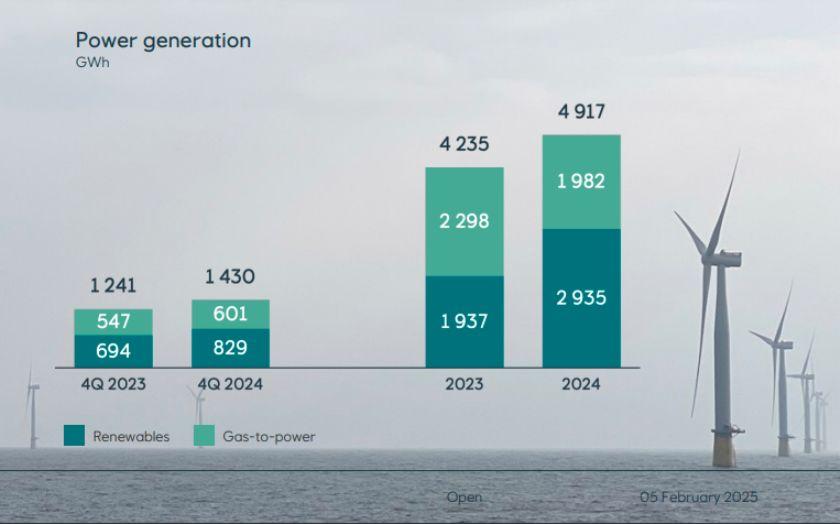Equinor has signaled a shift in its strategic approach by lowering its focus on renewable energy while reinforcing its core oil and gas business.
The company reported an adjusted operating income of USD 7.90 billion in the fourth quarter of 2024, with net operating income reaching USD 8.74 billion and net income at USD 2.00 billion. Adjusted earnings per share stood at USD 0.63.
Equinor has strengthened its outlook for oil and gas production, expecting more than 10 percent growth from 2024 to 2027, while at the same time reducing its investments in renewables and low-carbon solutions to approximately USD 5 billion in total for the period of 2025-2027 after project financing. Additionally, the company has lowered its expected installed renewable energy capacity to 10-12 gigawatts by 2030.
Equinor President and CEO Anders Opedal emphasized that Equinor remains committed to delivering industry-leading shareholder returns with a return on average capital employed projected to exceed 15 percent through 2030.
The company aims to significantly strengthen its expected free cash flow compared to previous outlooks by optimizing its portfolio, cutting costs, and reducing investment in renewables and low-carbon solutions.
While maintaining a long-term goal of net-zero emissions by 2050, Equinor has adapted to market conditions by prioritizing high-return projects and ensuring shareholder value. The company continues efforts to lower emissions from its operations and develop renewables and low-carbon solutions, but with a more selective and profitability-driven approach.
In the fourth quarter of 2024, Equinor completed ten offshore exploration wells, with four resulting in commercial discoveries. However, the Himalia and Cappahayden wells were expensed during the quarter.
On the renewable energy front, Equinor saw a 19 percent increase in power generation in the fourth quarter and a 51 percent increase for the full year compared to 2023, driven by the addition of onshore power plants in Brazil and Poland in 2023 and the startup of the Mendubim solar project in 2024. Despite these gains, Equinor remains focused on adjusting its renewable energy strategy to align with profitability targets.
Equinor also recognized net impairments of USD 280 million, primarily related to early-phase project rights acquired in onshore renewable energy markets. The company’s realized European gas price stood at USD 13.5 per million British thermal units (mmbtu), while realized liquids prices were USD 68.5 per barrel in the fourth quarter.
As part of its strategic realignment, Equinor has reassessed its renewables and low-carbon ambitions, focusing on projects with high returns while reducing early-stage investments. The company aims to achieve life-cycle equity returns of over 10 percent from its renewable energy projects. Its revised target for installed renewable energy capacity by 2030 has been lowered to 10-12 gigawatts, inclusive of its ownership stakes in Orsted and Scatec.
Meanwhile, Equinor remains a leader in carbon capture and storage (CCS), with a total storage capacity of 2.3 million tonnes of CO2 installed or under development. The company has retained its ambition to store 30-50 million tonnes of CO2 annually by 2035 and has secured licenses with the potential to store over 60 million tonnes per year.
Equinor has also retired its previous ambition to allocate 50 percent of gross capital expenditures to renewables and low-carbon solutions by 2030, underlining a more value-driven investment approach. Instead, the company will continue to adjust its energy transition strategy based on market conditions and economic viability.
Equinor’s updated energy transition plan outlines its commitment to value creation, emissions reduction, and the development of new energy solutions in pursuit of its net-zero target by 2050. The company maintains its goal of cutting Scope 1 and 2 emissions by 50 percent by 2030. However, it has adjusted its net carbon intensity (NCI) ambition, now targeting a 15-20 percent reduction by 2030 and a 30-40 percent reduction by 2035, reflecting the evolving market landscape.
For 2025, Equinor has estimated organic capital expenditures at USD 13 billion, maintaining a focus on high-return projects. Oil and gas production is expected to grow by 4 percent compared to 2024, reinforcing the company’s prioritization of traditional energy sources.
Baburajan Kizhakedath

